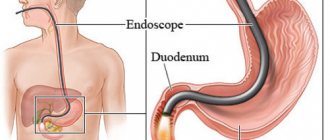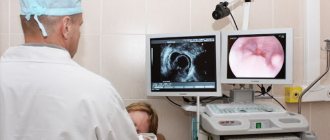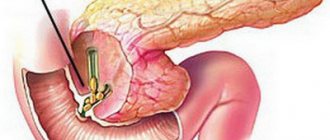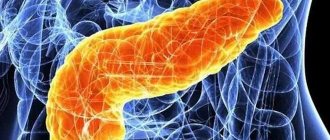How does surgery help reduce weight? ↑
The surgical procedure is based on the additional formation of a “small ventricle” that will hold from 20 to 50 ml of food. This is achieved by cutting the upper part of the stomach, after which an anamastosis occurs between the created small stomach and the small intestine.
Gastric bypass scheme
As a result, the food taken initially enters the “additional stomach”, and, bypassing the main paths of the digestive tract, immediately enters the small intestine, and then moves on.
Loss of excess weight is caused by less ingestion of beneficial elements, due to the fact that the small intestine is not involved in the digestion process; the second reason is a reduction in food intake due to a significant decrease in the volume of the stomach.
Sleeve gastroplasty: brief description
Sleeve gastroplasty is a restrictive bariatric surgery that limits the amount of food entering the body. This result is achieved by reducing the volume of the stomach by 10 times. After crossing its ligamentous apparatus, a long narrow tube “sleeve” is cut out along the lesser curvature using a special template, preserving the pyloric sphincter, located in the outlet section of the stomach. This narrow “ventricle” has a diameter of no more than 1.5-2 cm and further serves as a food container. The severed area of the stomach, including the fundus and most of the body, is removed through one of the laparoscopic approaches, which is slightly expanded for this purpose.
Subject to a special dietary regimen after gastric sleeve surgery, patients lose up to 80% of excess weight. However, the operation is not without its drawbacks. There is a risk:
- formation of hiatal hernia;
- development of obstruction of the stomach “sleeve”;
- deficiency of vitamin B12, the absorption of which requires a glycoprotein produced in the fundus of the stomach.
Necessary indications for surgery ↑
The main indications for surgical intervention include:
- body mass index (BMI) more than 40 kg/m2. In case the patient has diseases such as diabetes mellitus or hypertension, which are directly related to the process of obesity, this index drops to 35 kg/m2;
- diseases caused by excess weight;
- ineffective treatment of obesity through diet, sports and medication;
- eliminating disruptions in the endocrine system that cause obesity.
Gastric bypass - what is it, what is the difference between gastric resection and bypass surgery?
15 Jan
With the development of medicine, the operation has become widespread. However, many still do not know what this procedure is. Gastric bypass is a surgical procedure during which the surgeon reduces the volume of the patient's stomach, which ultimately leads to rapid weight loss. During the operation, the doctor divides the stomach into a small and a large part. The artificially formed gastric pouch is unable to accommodate large amounts of food. As a result, the feeling of fullness comes faster. Taking these features into account, we can distinguish two main functions that the operation provides:
Limiting – a person is unable to eat a lot of food at one time. Malabsorbent - the number of calories received decreases, the absorption of nutrients slows down.
What is the difference between gastric resection and bypass surgery? To begin with, it should be noted that there are many options and methods for performing the operation. However, its essence remains unchanged: the stomach is divided into 2 parts - small and large. The small intestine is directly connected to the small part. This is how gastric bypass is performed. However, patients are often confused about the concepts and until the very end cannot understand whether they are planning bypass surgery or resection. As for resection, there are key differences from bypass surgery:
During resection, about 80% of the stomach is removed longitudinally. A tube is formed from the remaining part - 3 cm in diameter and 150 ml in volume. When you eat food, it fills up and gives you a feeling of a full stomach. The artificially formed new stomach holds much less food, therefore the amount of food consumed is reduced.
Which is better - gastric bypass or balloon? One type of gastric surgery to reduce weight is the installation of a balloon. A silicone container is inserted into the organ cavity, which is inflated and thereby limits the volume of incoming food. As a result, it is possible to achieve the desired result in a short time. Compared to bypass surgery, the operation is no less effective. The main advantage of installing a balloon is that there is no need for surgery - it is installed endoscopically. However, there are several important disadvantages of the method, which gastric bypass surgery does not have:
Intragastric balloon is a temporary method. You cannot use it throughout your life. Duration of use is limited to 6–12 months, after which it must be removed. The possibility of a recurrence of the problem of weight gain or a return to previous forms cannot be ruled out. How is gastric bypass surgery performed? Having learned more about gastric bypass surgery, what it is and why it is performed, potential patients want to know about the operation algorithm itself. The surgery is performed under general anesthesia. The patient does not feel anything. Several small incisions are made on the anterior abdominal wall through which the laparoscope is inserted. If we briefly describe how gastric bypass is performed, then during the surgical intervention it is necessary to highlight the following points:
In the upper part of the stomach, where the esophagus flows, a small volume gastric pouch is made. From the formed small stomach a supply is made directly to the small intestine. As a result, food bypasses the main stomach, duodenum, and the initial part of the intestine. As a result of the manipulation, the swallowed food enters the small stomach, quickly fills it, and the patient feels full.
Gastric bypass - pros and cons Like any technique, bypass surgery has its advantages and disadvantages. The main advantage is the visible effect within a few weeks. According to doctors' observations, as a result of this bariatric surgery, in the first 1-2 years, body weight loss can amount to up to 70% of excess weight. Other benefits of the operation include:
lasting effect - after 5-6 years, weight loss remains within average limits; You can always perform a reverse operation to restore physiological digestion; after a certain time after the operation, the patient can freely engage in his favorite sports. Potential patients who dare to undergo surgery, in addition to the advantages, are also interested in the disadvantages and risks associated with the intervention. Before you sign up for gastric bypass surgery, whether it is dangerous, how the operation is performed, doctors tell you in detail and answer all questions. Among the risks and disadvantages that may await the patient, doctors identify:
Complication of the operation (formation of fistulas at the site of internal sutures). The need to constantly take prescribed vitamins, minerals, and protein shakes. Pronounced refusal of a number of drugs (NSAIDs, combined oral contraceptives).
Gastric bypass - indications The mere desire to undergo gastric bypass is not enough. Like any surgical intervention, the operation has its own indications for implementation. Before placing the patient on the operating table, doctors collect a complete medical history and carefully examine him. According to established criteria, patients are candidates for gastric bypass surgery if they meet one of the following criteria:
Body mass index (BMI) > 40; BMI is in the range of 35–40, with one of the following comorbidities: severe type 2 diabetes mellitus; Pickwick's syndrome; stopping breathing during sleep; cardiomyopathy due to obesity; osteoarthritis.
Gastric bypass for weight loss If you ask ordinary people why gastric bypass is performed and what it is, most will answer: an operation to lose weight. And indeed it is. After all, the main goal is to quickly eliminate extra pounds. However, it is worth noting that not everyone who is obese and wants to lose weight quickly can afford this procedure.
Main contraindications for surgery ↑
Gastric bypass surgery has many contraindications, which include:
- severe nature of the course of pulmonary and cardiovascular diseases;
- bearing a child;
- age restrictions (persons under the age of majority are prohibited from performing surgery);
- long-term use of medications, which include prednisolone, dexamethasone and others;
- patient's alcohol dependence;
- presence of autoimmune diseases;
- diseases of an infectious nature;
- diseases of the gastrointestinal tract.
Recovery
In general, the process of regeneration of the body lasts 2-3 months. In the first hours after gastric suturing surgery, you are prohibited from drinking water or eating any food. To support the body, a special saline solution is poured inside. Next, the patient can gradually eat liquid food and switch to different purees. This diet is maintained for approximately 1-2 weeks. Then regular healthy foods are introduced into the diet.
Before discharge, it is advisable for the patient to visit a nutritionist.
After 7-14 days after removal of part of the stomach, the patient is discharged from the clinic. Before this, doctors do control tests and ultrasound diagnostics. It is also necessary to discuss the basics of proper nutrition with a nutritionist. After a procedure such as gastric bypass, you should not engage in heavy physical work for 2-3 months. It is necessary to eliminate all stress and possible nervous tension.
Preparation for surgery ↑
Before the appointment of gastric bypass surgery, the patient undergoes a preliminary consultation with a surgeon, and only after this does the preparatory stage begin, which consists of mandatory clinical and laboratory tests.
As in preparation for any surgical intervention, the patient undergoes an ECG, a chest x-ray, an assessment of the respiratory system, and is sent for examination to specialized specialists and a local physician.
After passing all the tests, a date for surgery is set, and the patient strictly follows a special diet for 7 days.
To do this you need:
- Minimally reduce your intake of fatty foods;
- completely eliminate flour and sugar-containing products;
- eat no more than 200 g of lean meat;
- you can drink water without restrictions;
- reduce intake of potatoes and rice;
- eat no more than 1-1.5 pieces of fresh fruit or boiled vegetables;
- drink 200 ml of vegetable broth;
- Avoid taking acetylsalicylic acid, paracetamol, ibuprofen;
- the day before surgery, complete refusal of food and water.
Gastric recovery and side effects
In the initial period, the patient will need time for the operation of the operated stomach to adjust, and for him to adapt to the new operating mode. Serious discomfort when eating and vomiting may occur. There may also be serious difficulties that you need to know about in advance.
Dumping syndrome
After gastric bypass surgery, you may experience intolerance to certain types of food, usually fatty foods, dairy products or sweets. The products may cause unpleasant symptoms similar to motion sickness, such as sweating with nausea, stomach pain and diarrhea. This is called dumping syndrome. Some patients find this a beneficial side effect because it increases aversion to high-calorie foods. Therefore, it is important to monitor your diet and consume only recommended food groups.
Fast weight loss
A person may quickly lose a large amount of weight in the first few months after gastric bypass surgery. Although this is exactly the effect that the surgery is intended to achieve, it is important that the weight loss proceeds at a relatively slow pace to avoid side effects such as fatigue and hair loss. Therefore, a program of rehabilitation, nutrition, and condition monitoring has been developed for those who have undergone surgery.
Weight return
As with any bariatric procedure, there are situations in which weight increases again even with the stomach operated on. If a person regularly overeats, they can stretch the pouch or anastomosis, causing the weight to return. Therefore, we need a transition to healthy foods and drinks, physical activity and a healthy lifestyle.
Surgical intervention ↑
Gastric bypass surgery is performed using general anesthesia. The surgery lasts from 2 to 4 hours.
Small punctures are made in the abdominal wall, through which a laparoscope is inserted, which is equipped with a miniature video camera and special manipulators. The entire operation is carried out under the supervision of the operating surgeon.
First, the laparoscope is brought to the stomach and small intestine, then the necessary manipulations are performed: a “small” stomach and anastomoses between the stomach and small intestine are created, finally the holes are sutured and a sterile bandage is applied to the puncture sites.
After the operation, the patient requires intensive care and medical supervision; if the patient is feeling satisfactory, the doctor gives permission to transfer the patient to a regular ward.
Operation stages
The operation is performed under general anesthesia and lasts from 2 to 6 hours.
Stages of laparoscopic gastric bypass surgery:
- Several punctures are made on the front wall of the abdomen.
- Instruments for the operation and a laparoscope (a thin tube with a light and camera) are inserted through the punctures.
- The stomach is divided into two parts - “small” (volume 20-50 ml) and “large” (the remaining volume of the stomach after separation of the “small”). The upper edge of the large stomach is sutured, only the “small stomach” functions.
- Next, an incision is made into the small intestine, the lower end of which is sutured to the “small stomach”. This will be the main digestive tube.
- The upper part of the small intestine is sutured closer to the large intestine. This digestive tube is necessary for the passage of bile.
- After examining the abdominal cavity and there is no bleeding, the instruments and laparoscope are removed from the abdominal cavity, and the surgical openings are sutured.
Possible complications ↑
The surgical intervention can lead to quite serious complications:
- due to an increase in the size of the connective tissue, the junction narrows, which threatens anostasis stenosis;
- in the place where the additionally created stomach and small intestine connect, a peptic ulcer may occur;
- constipation develops due to intestinal dysfunction;
- a significant decrease in the volume of the stomach and intestines leads to less absorption of nutrients from food taken, which leads to hypovitaminosis.
Life after gastric bypass
If there are no complications, the patient is discharged from the hospital after 7-10 days. He must be instructed about his future lifestyle (primarily nutrition and diet), possible complications and ways to prevent them.
If the work does not involve heavy physical activity, you can return to work after two weeks. Sports activities are limited for two months. Physical activity without straining the abdominal wall (for example, walking) is recommended. After two months, swimming, cycling, and aerobics are allowed.
Women are advised to protect themselves from pregnancy for a year.
Possible complications in the long-term postoperative period:
- Development of scar narrowing of the anastomosis. In this case, symptoms of partial gastrointestinal obstruction will develop: nausea, vomiting, inability to take first solid and then any food. Eliminated by repeated surgery.
- Peptic ulcer of the anastomosis. Symptoms: pain on an empty stomach, nausea, vomiting. Antiulcer conservative treatment is prescribed.
- Dumping syndrome. It occurs as a reflex vegetative reaction to the rapid entry of food (especially fast carbohydrates) into the small intestine. It manifests itself as severe weakness, palpitations, a feeling of heat, and sweating.
Patients usually learn from experience to prevent dumping syndrome. To do this, you need to exclude sweets, confectionery, sugary drinks, ice cream, do not mix food with drink, and eat slowly.
Some even consider dumping syndrome a useful complication: out of fear of experiencing unpleasant sensations, a person stops eating sweets, which also contributes to weight loss.
- Development of hypovitaminosis, anemia and lack of minerals due to malabsorption. As a preventive measure, patients after gastric bypass are prescribed multivitamins, iron and calcium supplements.
- Development of postoperative hernias. For prevention, it is recommended to follow a gentle regimen, wear a postoperative bandage, and prevent constipation.
- Development of cholelithiasis. Due to the inevitable stagnation of bile, the formation of stones with corresponding symptoms is possible. It may be necessary to remove the gallbladder. Some clinics offer to remove the gallbladder at the same time as gastric bypass surgery.
Weight loss after surgery occurs gradually and reaches stable values after approximately 1 – 1.5 years. Problems associated with obesity also gradually go away: blood sugar is normalized, blood pressure is significantly reduced, pain in the spine and joints decreases or disappears, and menstrual function in women is normalized.
It should be noted that many patients, as a result of large weight loss, develop large folds of skin and fat (especially on the abdomen), sometimes hanging down like an apron and limiting physical activity. Such patients are recommended to undergo plastic surgery to remove such folds (abdominoplasty).
How to eat? ↑
After the operation, the patient must strictly adhere to the doctor’s instructions regarding food intake, we list the main recommendations:
- after the operation, for two weeks, the patient can drink still water, and all food consumed should be in liquid or puree form;
- in the future, due to a significant decrease in stomach volume, you need to eat only fractionally and in small portions;
- It is prohibited to drink alcohol or drinks with gas;
- Regular use of vitamins is mandatory.
Some restrictions must be adhered to only at the beginning of the rehabilitation period:
- be sure to stay in bed for 24 hours;
- abstain from intimate relations for two weeks;
- Any physical activity is prohibited for 2 months;
- It is not recommended to carry a child for 1-2 years after surgery.
Progress of the operation
Gastric bypass surgery for weight loss occurs in a hospital setting, after examination of the body. Operation stages:
- The surgeon cuts the stomach into two unequal parts. Thus, it forms a small stomach, the volume of which should be up to 50 milliliters.
- Most of the organ is sutured because it will no longer function.
- A loop of the small intestine, the length of which is 1 m, is attached to a small area of the organ.
- A special bandage is attached to the small stomach.
Undesirable consequences
Unpleasant consequences can be avoided by eating in small portions.
The main advantage of the intervention is the minimal number of side effects. Of these, only the gag reflex from food, constipation or diarrhea are distinguished. This may occur due to eating food quickly. Gastric motility disorders also occur. In order not to aggravate the unpleasant consequences, it is worth following these instructions:
- take food in small portions 5-6 times a day;
- do not drink water in large quantities (maximum 1.5 liters per day);
- Avoid drinking alcoholic drinks and soda;
- take medications that stabilize the functionality of the stomach.
In especially severe cases, after the intervention, an inflammatory process may begin, which entails internal bleeding.
Issue price ↑
How much does gastric bypass surgery cost? The average cost of surgical intervention associated with gastric laparoscopy varies from 170 to 210 thousand rubles. The price of the operation consists of the following parameters: doctor’s consultation, anesthesia used, complexity of the operation, popularity of the clinic and the name of the surgeon. The cost of the operation increases depending on the location of laparoscopy (Moscow, regions).
Before the operation, familiarize yourself with the portfolio of the surgeon who will perform the operation, look at photos of operated patients before and photos after surgery, read patient reviews, if most of the reviews are positive and you really liked the photos of thinner patients, decide to have the operation and wait for the result, of course a positive one .
Contraindications
Despite its effectiveness, there are a number of contraindications in which gastric surgery is undesirable. The operation is not performed if the following conditions are observed:
This intervention is contraindicated for HIV-infected patients.
- age up to 18 years and elderly people over 70 years of age;
- pregnancy, breastfeeding;
- serious problems of the cardiovascular system;
- lung diseases (bilateral inflammation, bronchitis, tuberculosis);
- malignant tumors;
- the last stages of alcoholism and drug addiction;
- HIV infections;
- personal intolerance to anesthesia.
If the patient is taking steroid or hormonal drugs, he should refuse the procedure.
Is a diet necessary before the procedure?
Before undergoing a procedure such as gastric bypass, you need to follow a diet that will remove excess fat from the liver. The foods listed in the table are included in the weekly diet before the intervention:
| type of product | What exactly? | Daily value, g |
| Lean meat | Boiled meat: chicken and turkey fillet, rabbit, young veal | 300 |
| Vegetables | Carrots, tomatoes, cucumbers, pumpkin, beets | 200 |
| Fruits | Apples, pears, apricots | 300 |
| Milk products | Low-fat milk, cottage cheese, natural yogurt or kefir | 1 glass |
| Porridge | Buckwheat, millet, lentils | 200 |
Carrying out the operation
The laparoscopic bypass method will allow you to recover after surgery in the shortest possible time
As mentioned above, gastric bypass surgery is performed laparoscopically. A puncture is made in the anterior abdominal wall using a special device, which significantly reduces trauma. The rehabilitation period is easier and faster. Bypass surgery takes about 1-4 hours. Gastric surgery is performed under general anesthesia. After the intervention, the operated patient is transported to a special ward.
It is worth noting that after the mini-operation the patient may feel pain for several days. To avoid such discomfort and reduce pain, the doctor prescribes painkillers.
You can get up after such an operation the next day. However, full physical activity will return only after seven days. In this case, you will not be able to lift weights for a long time.
Advice: to prevent the formation of blood clots, you must wear compression garments or elastic bandages in the postoperative period.
After gastric bypass surgery, the patient will have to stay in the hospital for another five days.











